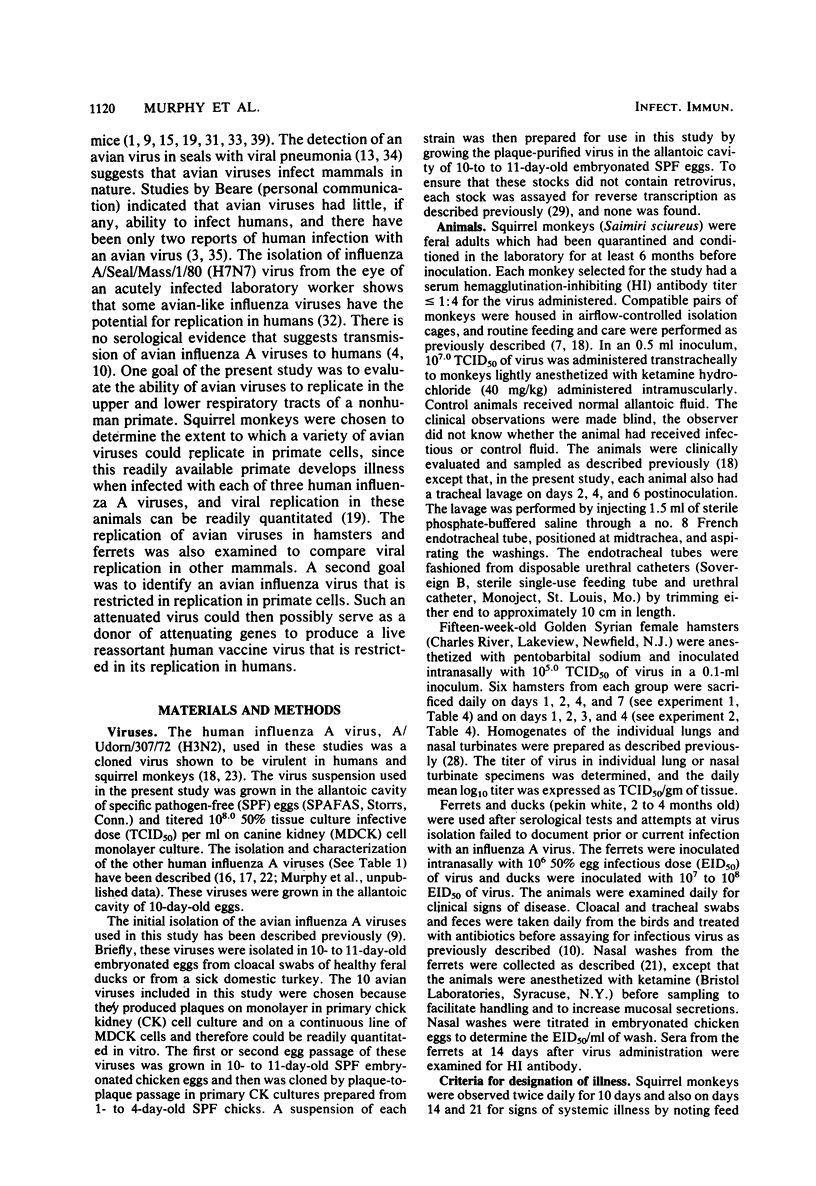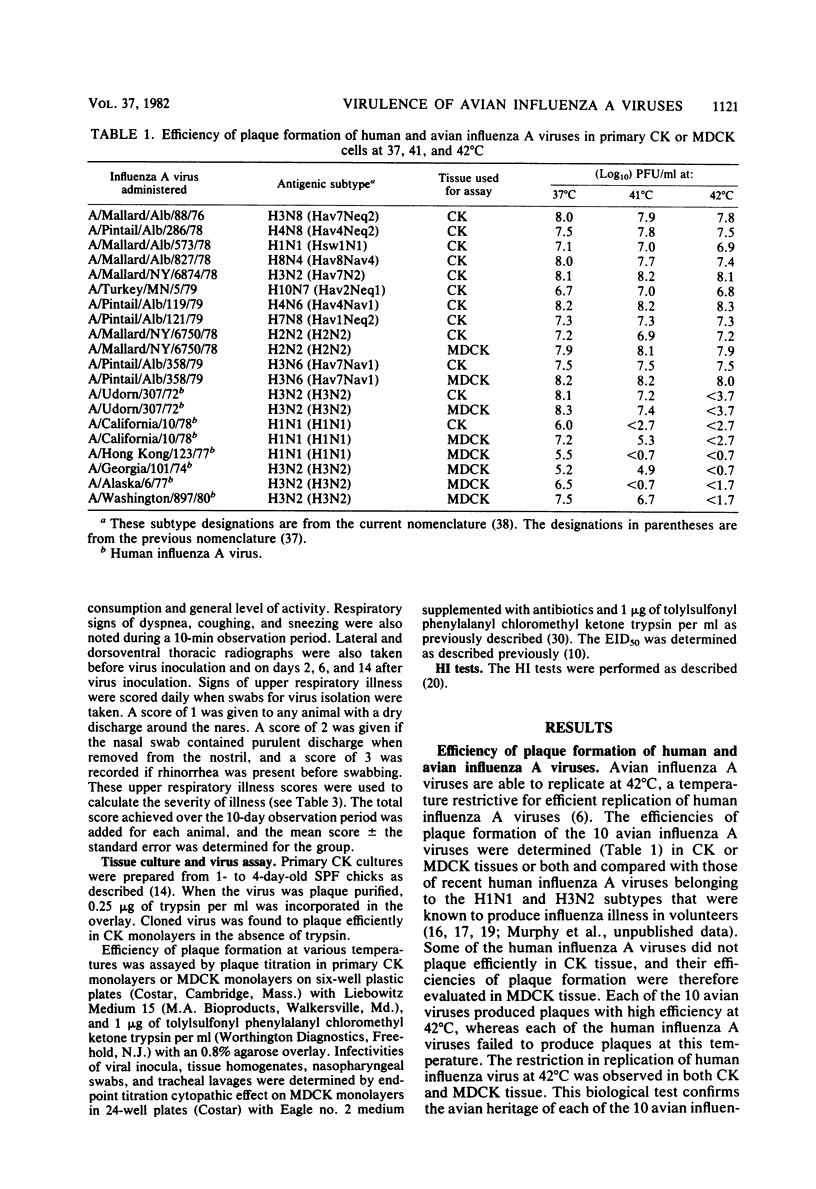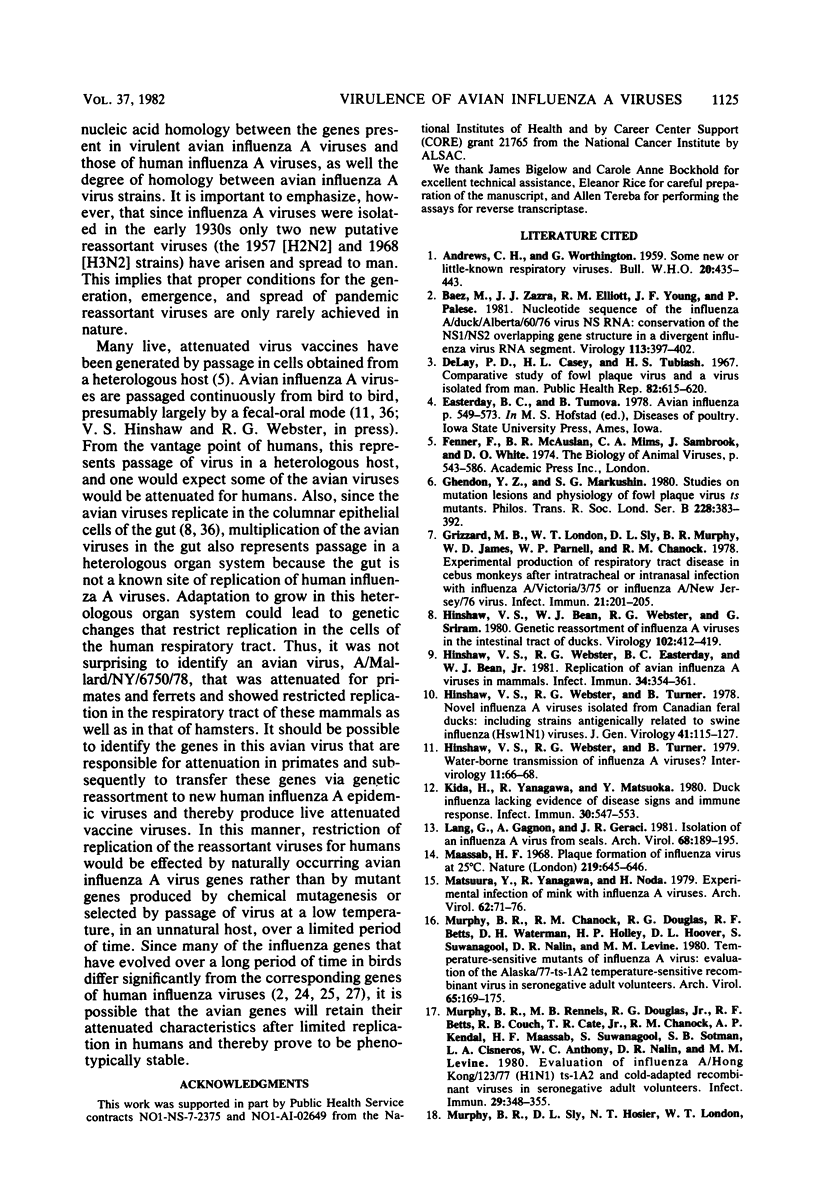Abstract
Ten serologically distinct avian influenza A viruses were administered to squirrel monkeys and hamsters to compare their replication and virulence with those of human influenza A virus, A/Udorn/307/72 (H3N2). In squirrel monkeys, the 10 avian influenza A viruses exhibited a spectrum of replication and virulence. The levels of virus replication and clinical response were closely correlated. Two viruses, A/Mallard/NY/6874/78 (H3N2) and A/Pintail/Alb/121/79 (H7N8), resembled the human virus in their level and duration of replication and in their virulence. At the other end of the spectrum, five avian viruses were restricted by 100- to 10,000-fold in replication in the upper and lower respiratory tract and were clearly attenuated compared with the human influenza virus. In hamsters, the 10 viruses exhibited a spectrum of replication in the nasal turbinates, ranging from viruses that replicated as efficiently as the human virus to those that were 8,000- fold restricted. Since several avian viruses were closely related serologically to human influenza viruses, studies were done to confirm the avian nature of these isolates. Each of the avian viruses plaqued efficiently at 42°C, a restrictive temperature for replication of human influenza A viruses. Avian strains that had replicated either very efficiently or very poorly in squirrel monkeys still grew to high titer in the intestinal tracts of ducks, a tropism characteristic of avian, but not mammalian, influenza viruses. These observations indicate that some avian influenza A viruses grow well and cause disease in a primate host, whereas other avian viruses are very restricted in this host. These findings also provide a basis for determining the gene or genes involved in the restriction of replication that is observed with the attenuated avian viruses. Application of such information may allow the preparation of reassortant viruses derived from a virulent human influenza virus and an attenuated avian virus for possible use in a live attenuated vaccine for prevention of influenza in humans.
Full text
PDF







Selected References
These references are in PubMed. This may not be the complete list of references from this article.
- ANDREWES C. H., WORTHINGTON G. Some new or little-known respiratory viruses. Bull World Health Organ. 1959;20(2-3):435–443. [PMC free article] [PubMed] [Google Scholar]
- Baez M., Zazra J. J., Elliott R. M., Young J. F., Palese P. Nucleotide sequence of the influenza A/duck/Alberta/60/76 virus NS RNA: conservation of the NS1/NS2 overlapping gene structure in a divergent influenza virus RNA segment. Virology. 1981 Aug;113(1):397–402. doi: 10.1016/0042-6822(81)90166-5. [DOI] [PubMed] [Google Scholar]
- DeLay P. D., Casey H. L., Tubiash H. S. Comparative study of fowl plague virus and a virus isolated from man. Public Health Rep. 1967 Jul;82(7):615–620. [PMC free article] [PubMed] [Google Scholar]
- Ghendon Y. Z., Markushin S. G. Studies on mutation lesions and physiology of fowl plague virus ts mutants. Philos Trans R Soc Lond B Biol Sci. 1980 Feb 25;288(1029):383–392. doi: 10.1098/rstb.1980.0015. [DOI] [PubMed] [Google Scholar]
- Grizzard M. B., London W. T., Sly D. L., Murphy B. R., James W. D., Parnell W. P., Chanock R. M. Experimental production of respiratory tract disease in cebus monkeys after intratracheal or intranasal infection with influenza A/Victoria/3/75 or influenza A/New Jersey/76 virus. Infect Immun. 1978 Jul;21(1):201–205. doi: 10.1128/iai.21.1.201-205.1978. [DOI] [PMC free article] [PubMed] [Google Scholar]
- Hinshaw V. S., Bean W. J., Webster R. G., Sriram G. Genetic reassortment of influenza A viruses in the intestinal tract of ducks. Virology. 1980 Apr 30;102(2):412–419. doi: 10.1016/0042-6822(80)90108-7. [DOI] [PubMed] [Google Scholar]
- Hinshaw V. S., Webster R. G., Easterday B. C., Bean W. J., Jr Replication of avian influenza A viruses in mammals. Infect Immun. 1981 Nov;34(2):354–361. doi: 10.1128/iai.34.2.354-361.1981. [DOI] [PMC free article] [PubMed] [Google Scholar]
- Hinshaw V. S., Webster R. G., Turner B. Novel influenza A viruses isolated from Canadian feral ducks: including strains antigenically related to swine influenza (Hsw1N1) viruses. J Gen Virol. 1978 Oct;41(1):115–127. doi: 10.1099/0022-1317-41-1-115. [DOI] [PubMed] [Google Scholar]
- Hinshaw V. S., Webster R. G., Turner B. Water-bone transmission of influenza A viruses? Intervirology. 1979;11(1):66–68. doi: 10.1159/000149014. [DOI] [PubMed] [Google Scholar]
- Kida H., Yanagawa R., Matsuoka Y. Duck influenza lacking evidence of disease signs and immune response. Infect Immun. 1980 Nov;30(2):547–553. doi: 10.1128/iai.30.2.547-553.1980. [DOI] [PMC free article] [PubMed] [Google Scholar]
- Lang G., Gagnon A., Geraci J. R. Isolation of an influenza A virus from seals. Arch Virol. 1981;68(3-4):189–195. doi: 10.1007/BF01314571. [DOI] [PubMed] [Google Scholar]
- Maassab H. F. Plaque formation of influenza virus at 25 degrees C. Nature. 1968 Aug 10;219(5154):645–646. doi: 10.1038/219645a0. [DOI] [PubMed] [Google Scholar]
- Matsuura Y., Yanagawa R., Noda H. Experimental infection of mink with influenza A viruses. Brief report. Arch Virol. 1979;62(1):71–76. doi: 10.1007/BF01314905. [DOI] [PubMed] [Google Scholar]
- Murphy B. R., Chanock R. M., Douglas R. G., Betts R. F., Waterman D. H., Holley H. P., Jr, Hoover D. L., Suwanagool S., Nalin D. R., Levine M. M. Temperature-sensitive mutants of influenza A virus: evaluation of the Alaska/77-ts-1A2 temperature-sensitive recombinant virus in seronegative adult volunteers. Arch Virol. 1980;65(2):169–173. doi: 10.1007/BF01317328. [DOI] [PubMed] [Google Scholar]
- Murphy B. R., Rennels M. B., Douglas R. G., Jr, Betts R. F., Couch R. B., Cate T. R., Jr, Chanock R. M., Kendal A. P., Maassab H. F., Suwanagool S. Evaluation of influenza A/Hong Kong/123/77 (H1N1) ts-1A2 and cold-adapted recombinant viruses in seronegative adult volunteers. Infect Immun. 1980 Aug;29(2):348–355. doi: 10.1128/iai.29.2.348-355.1980. [DOI] [PMC free article] [PubMed] [Google Scholar]
- Murphy B. R., Sly D. L., Hosier N. T., London W. T., Chanock R. M. Evaluation of three strains of influenza A virus in humans and in owl, cebus, and squirrel monkeys. Infect Immun. 1980 Jun;28(3):688–691. doi: 10.1128/iai.28.3.688-691.1980. [DOI] [PMC free article] [PubMed] [Google Scholar]
- Ottis K., Bachmann P. A. Occurrence of Hsw 1 N 1 subtype influenza A viruses in wild ducks in Europe. Arch Virol. 1980;63(3-4):185–190. doi: 10.1007/BF01315025. [DOI] [PubMed] [Google Scholar]
- Potter C. W., Oxford J. S., Shore S. L., McLaren C., Stuart-Harris C. Immunity to influenza in ferrets. I. Response to live and killed virus. Br J Exp Pathol. 1972 Apr;53(2):153–167. [PMC free article] [PubMed] [Google Scholar]
- Richman D. D., Murphy B. R., Belshe R. B., Rusten H. M., Chanock R. M., Blacklow N. R., Parrino T. A., Rose F. B., Levine M. M., Caplan E. Temperature-sensitive mutants of influenza A virus. XIV. Production and evaluation of influenza A/Georgia/74-ts-1[E] recombinant viruses in human adults. J Infect Dis. 1977 Aug;136(2):256–262. doi: 10.1093/infdis/136.2.256. [DOI] [PubMed] [Google Scholar]
- Richman D. D., Murphy B. R., Chanock R. M., Gwaltney J. M., Jr, Douglas R. G., Betts R. F., Blacklow N. R., Rose F. B., Parrino T. A., Levine M. M. Temperature-sensitive mutants of influenza A virus. XII. Safety, antigenicity, transmissibility, and efficacy of influenza A/Udorn/72-ts-1[E] recombinant viruses in human adults. J Infect Dis. 1976 Dec;134(6):585–594. [PubMed] [Google Scholar]
- Rohde W., Harms E., Scholtissek C. Biochemical studies on influenza viruses. I. Comparative analysis of equine 2 virus and virus N genes and gene products. Virology. 1977 Jun 15;79(2):393–404. doi: 10.1016/0042-6822(77)90366-x. [DOI] [PubMed] [Google Scholar]
- Scholtissek C., Harms E., Rohde W., Orlich M., Rott R. Correlation between RNA fragments of fowl plague virus and their corresponding gene functions. Virology. 1976 Oct 15;74(2):332–344. doi: 10.1016/0042-6822(76)90340-8. [DOI] [PubMed] [Google Scholar]
- Scholtissek C., Rohde W., Von Hoyningen V., Rott R. On the origin of the human influenza virus subtypes H2N2 and H3N2. Virology. 1978 Jun 1;87(1):13–20. doi: 10.1016/0042-6822(78)90153-8. [DOI] [PubMed] [Google Scholar]
- Scholtissek C., von Hoyningen-Huene V. Genetic relatedness of the gene which codes for the nonstructural (NS) protein of different influenza A strains. Virology. 1980 Apr 15;102(1):13–20. doi: 10.1016/0042-6822(80)90065-3. [DOI] [PubMed] [Google Scholar]
- Spring S. B., Maassab H. F., Kendal A. P., Murphy B. R., Chanock R. M. Cold adapted variants of influenza A. II. Comparison of the genetic and biological properties of ts mutants and recombinants of the cold adapted A/AA/6/60 strain. Arch Virol. 1977;55(3):233–246. doi: 10.1007/BF01319909. [DOI] [PubMed] [Google Scholar]
- Tereba A., Murti K. G. A very sensitive biochemical assay for detecting and quantitating avian oncornaviruses. Virology. 1977 Jul 1;80(1):166–176. doi: 10.1016/0042-6822(77)90389-0. [DOI] [PubMed] [Google Scholar]
- Tolpin M. D., Massicot J. G., Mullinix M. G., Kim H. W., Parrott R. H., Chanock R. M., Murphy B. R. Genetic factors associated with loss of the temperature-sensitive phenotype of the influenza A/Alaska/77-ts-1A2 recombinant during growth in vivo. Virology. 1981 Jul 30;112(2):505–517. doi: 10.1016/0042-6822(81)90298-1. [DOI] [PubMed] [Google Scholar]
- Uys C. J., Becker W. B. Experimental infection of chickens with influenza A-Tern/South Africa/1961 and Chicken/Scotland/1959 viruses. II. Pathology. J Comp Pathol. 1967 Apr;77(2):167–173. doi: 10.1016/0021-9975(67)90007-2. [DOI] [PubMed] [Google Scholar]
- Webster R. G., Geraci J., Petursson G., Skirnisson K. Conjunctivitis in human beings caused by influenza A virus of seals. N Engl J Med. 1981 Apr 9;304(15):911–911. doi: 10.1056/NEJM198104093041515. [DOI] [PubMed] [Google Scholar]
- Webster R. G., Hinshaw V. S., Bean W. J., Sriram G. Influenza viruses: transmission between species. Philos Trans R Soc Lond B Biol Sci. 1980 Feb 25;288(1029):439–447. doi: 10.1098/rstb.1980.0021. [DOI] [PubMed] [Google Scholar]
- Webster R. G., Hinshaw V. S., Bean W. J., Van Wyke K. L., Geraci J. R., St Aubin D. J., Petursson G. Characterization of an influenza A virus from seals. Virology. 1981 Sep;113(2):712–724. doi: 10.1016/0042-6822(81)90200-2. [DOI] [PubMed] [Google Scholar]
- Webster R. G., Laver W. G. The origin of pandemic influenza. Bull World Health Organ. 1972;47(4):449–452. [PMC free article] [PubMed] [Google Scholar]
- Webster R. G., Yakhno M., Hinshaw V. S., Bean W. J., Murti K. G. Intestinal influenza: replication and characterization of influenza viruses in ducks. Virology. 1978 Feb;84(2):268–278. doi: 10.1016/0042-6822(78)90247-7. [DOI] [PMC free article] [PubMed] [Google Scholar]
- Yagyu K., Yanagawa R., Matsuura Y., Noda H. Contact infection of mink with influenza A viruses of avian and mammalian origin. Arch Virol. 1981;68(2):143–145. doi: 10.1007/BF01314444. [DOI] [PubMed] [Google Scholar]


